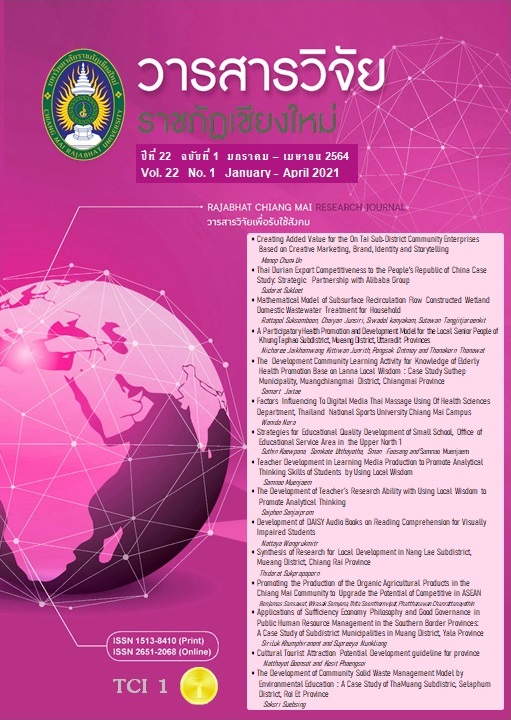Applications of Sufficiency Economy Philosophy and Good Governance in Public Human Resource Management in the Southern Border Provinces: A Case Study of Subdistrict Municipalities in Muang District, Yala Province
DOI:
https://doi.org/10.14456/rcmrj.2021.240172Keywords:
Sufficiency economy, Good governance, Human resources management in the public sectorAbstract
This research had the objective to study the applications of the principles of sufficiency economy and good governance in public human resource management in the southern border provinces. This study looked at problems and risks in application of the principles, and offers recommendations for improving the application of these two principles. Data were collected from a sample of 121 persons, and analyzed using descriptive statistics. This study found that application of sufficiency economy and good governance in human resources management in the southern border province s was at an overall moderate level (Mean = 3.44, Standard diviation = 0.89). The level of problems in application of these two principles was at a low level (Mean = 2.46, Standard diviation = 1.08). Managing risk in application of these two principles was at a moderate level, and the application of these principles for human resources management in the southern border provinces was at a high level (Mean = 3.78, Standard diviation = 0.80).
References
Akahat, N. (2017). Guidelines on Human Capital Management for Local Administrative Organizations in Thailand towards High Performance Organization in Public Services in the 21St Century . Kasetsart University Political Science Review Journal (KUPSRJ), 4(1), 1-30. (In Thai)
Changmai, R. (2015). The Development of Human Resource Administration Model Based on Good Governance of School Under The Bureau of Pattaya City. Journal of Rajanagarindra, 12(28), 195-207. (In Thai)
Duangchinda, T., & Ritthirod, T. (2013). Risk management in human resource management of Phosai Subdistrict Administration Organization Phibunmangsahan District, Ubonratchathani Province. Journal of Graduate Study in Humanities and Social Sciences, 2(2), 15-34. (In Thai)
Kaewkohsaba, A. (2017). Principles of Good Governance in the Constitution of the Kingdom of Thailand 2017. Bangkok: Academic Office, Secretariat of the House of Representatives. (In Thai)
Kawsanga, K.. (2015). Application of The New Public Management to Human Resource Management of Kamnoetnopphakhun Sub-District Municipality, Bangsaphan District, Prachuapkhirikhan Province. Journal of Interdisciplinary Research: Graduate Studies, 4 (3), 104-113. (In Thai)
Ketsuwan, R. (2012). Concept and theory of local government. Bangkok: Bophit Printing. (In Thai)
Khamphab, P. (2006). Applying good governance principles in the administration of schools under Educational Service Area Office Khon Kaen District 1. (Master of Science, Loei Rajabhat University). Retrieved from http://newtdc.thailis.or.th/docview.aspx?tdcid=3996 (In Thai)
Lerknok, N., & Tansrisakul, S. (2017, September). Guidelines for human resource development of sub-district administrative organizations in Borabue district Mahasarakham Province. Documents presented to the meeting of the 13th Mahasarakham University Academic Conference, Maha Sarakham. (In Thai)
Office of the Public Sector Development Commission. (2009). Handbook for Organizational Governance Leveling Government sector in accordance with the principles of good governance (Good Governance Rating). Bangkok: Premier Pro. (In Thai)
Pongsapich, A. (1998). Dharmarat and Dharmarat and civil society organization. Documents presented to the meeting of the academic conference on the 50th anniversary of the Faculty of Political Science, Chulalongkorn University, Bangkok. (In Thai)
Ponthongmak, M., Wannasri, J., Jansila, V., & Mejang, S. (2015). A Model of Personnel Administration with Good Governance in Basic Schools. Journal of Education Naresuan University, 17(3), 32-40. (In Thai)
Prommachan, S., & Siripirom, W. (2016). Risks on human resource management of Somruethai Wittaya Lampang School. An Online Journal of Educational, 11(4), 313 - 328. (In Thai)
Santhaweesuk, R., & Thamikbovorn, S. (2015, March). Personnel Development according to Sufficiency Economy Philosophy: of the Nakasang Subdistrict Administrative Organization, Det Udom District, Ubon Ratchathani Province. Research Work at Graduate Studies (Symposium) No. 7, Ubon Ratchathani. (In Thai)
Sengsim, J. (2012). Application of Good Governance for Human Resource Management in the Sirindhorn Southern College of Public Health Network. Journal of Nursing and Education, 5(1), 115 -127. (In Thai)
Sreepaibua, S., & Yuenyaw, P. (2012). Use of Good Governance Principles for Personnel Administration in Basic Educational Institutions Under the Jurisdiction of Nakhon Pathom Primary Educational Service Area Office 1. Journal of Social Sciences Research, 3 (1), 80-98. (In Thai)
Thongpakdee, N. (2011). Philosophy of Sufficiency Economy and Thai Society. Bangkok: Sufficiency Economy Study Center National Institute of Development Administration. (In Thai)
Tongrod, P. (2014). A Human Resource Development of Local Government for Sustainable Development. Kasetsart University Political Science Review Journal (KUPSRJ), 1(2), 43-69. (In Thai)
Yodprudikan, P. (2007). What does sufficiency economy mean?. Bangkok: Thaipat Institute. (In Thai)
Downloads
Published
How to Cite
Issue
Section
License
1. Articles, information, content, images, etc published in the “Community and Social Development Journal” are copyrighted by the Community and Social Development Journal, Chiang Mai Rajabhat University. In order to properly distribute the articles through print and electronic media, the authors still hold the copyright for the published articles under the Creative Commons Attribution (CC BY) license, which allows the re-distribution of the articles in other sources. References must be made to the articles in the journal. The authors are responsible for requesting permission to reproduce copyrighted content from other sources.
2. The content of the articles appearing in the journal is the direct responsibility of the article authors. The editorial board of the journal does not necessarily agree with or share any responsibility.













